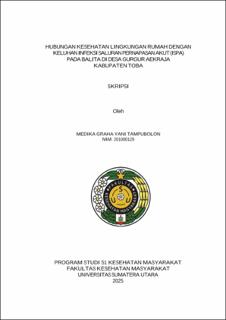| dc.description.abstract | ARI is the leading cause of morbidity and mortality in children under five years of
age worldwide, including in Indonesia. Based on the Tampahan Health Center
report, there were 17.3% of ARI cases in 2023, placing this disease as the disease
with the highest visits, especially in toddlers aged 2-5 years. The physical
condition of the house and the behavior of family members are factors that are
thought to potentially increase the risk of ARI in toddlers. This study aims to
analyze the relationship between household environmental health and the
incidence of Acute Respiratory Infections (ARI) in toddlers in Gurgur Village
Aekraja Toba District. This study used a cross-sectional design with a sample size
of 50 respondents selected through purposive sampling technique. Data analysis
methods using univariate analysis and bivariate analysis with Chi-square test.
The results of the analysis showed that there was a relationship between
ventilation (p value = 0,027), occupancy density (p value = 0,044), humidity (p
value = 0,041), smoking in the house (p value = 0,023) the use of mosquito
repellent (p value = 0,026), burning garbage (p value = 0,017), and exclusive
breastfeeding (p value = 0,009) with ARI complaints in toddlers. Meanwhile,
there is no relationship between temperature (p value = 0,938) and type of floor
(p value = 0,631) with ARI complaints in children under five. Houses with
inappropriate environmental health conditions will play a role in increasing the
risk of ARI in children under five. It is recommended that the community maintain
the health of the home environment to reduce the risk of ARI in toddlers. | en_US |


